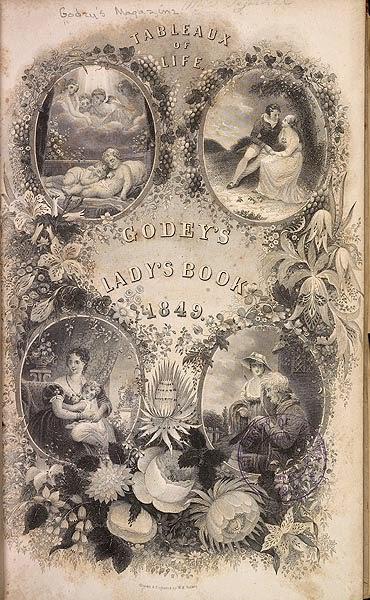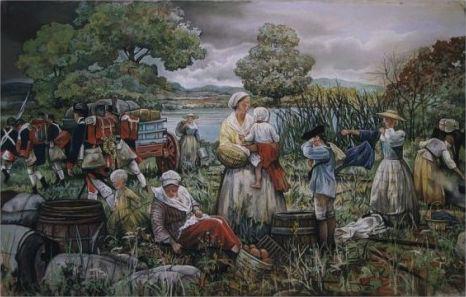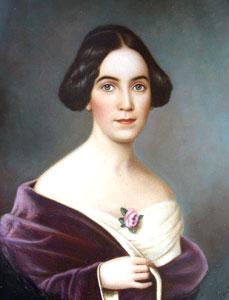Farm on the Gettysburg Battlefield Gettysburg farmer James Leister died in 1859, leaving his wife Lydia Leister and five children, ranging in age from 21 to 3. In March 1861, the widow Leister purchased a nine acre farm on Taneytown Road from Henry Bishop, Sr. for the sum of $900. The property included a modest, wood frame house with a single fireplace, two rooms and a stairway that lead to a small loft. Image: Restored Lydia Leister Farm today Looking north along Taneytown Road After the strong Confederate win at the Battle of Chancellorsville in May 1863 CSA General Robert E. Lee effectively argued that the best use of limited Confederate resources was to invade Pennsylvania. In early June he…

First Women Magazine Editors
Early Women Magazine Editors: Few and Far Between Ladies’ Magazine (1827-1836) was the first American magazine edited by a woman: Sarah Josepha Hale. In 1837 it merged with Lady’s Book and Magazine to become Godey’s Lady’s Book. Hale moved from Boston to Philadelphia to edit the new magazine. She did not regret the move. Image: 1849 Cover of Godey’s Lady’s Book Sarah Josepha Hale, Editor For the most part, women’s magazines of the nineteenth century focused on concerns seen as appropriate to woman’s sphere. Advertisers found the traditional home-centered woman to be an excellent customer for their clothing, cosmetics and household products; therefore, they preferred to patronize publications that would not lead women to question their place in society.
Ellen Swallow Richards
Pioneer Chemist and First Woman to Graduate from MIT The most prominent American woman chemist of the 19th century, Ellen Swallow Richards (1842–1911) was a pioneer in sanitary engineering and the founder of home economics in the United States. She was the first woman admitted to any scientific school in the United States and the first female graduate of MIT. During her career, she also helped her break new ground for women in science. Early Years Born December 3, 1842 at Dunstable, Massachusetts, Ellen Henrietta Swallow was the only child of well-educated parents and received most of her early education from them. In 1859 the family moved one town over to Westford, Massachusetts, where her father opened a store. Ellen…

First Women Nurses
History of American Women Nurses Nurses in the Revolutionary War (1775-1783) The Revolutionary War shifted the role of some women from housewives to caregivers on the battlefront. Soon after the Continental Army was created in 1775 to fight in the Revolutionary War, General George Washington was made aware that the wounded and sick required good female nurses, as the wounded soldiers were suffering greatly. Image: Following the Army by Pamela Patrick White Many women camp followers were hired to serve as nurses in the Continental Army Backstory Throughout history most healthcare took place in the home by family, friends and neighbors with knowledge of healing practices. In the United States, family-centered sick care remained traditional until the nineteenth century. Sick…
Ada Kepley
First American Woman to Graduate from Law School Ada Kepley was the first woman in the United States to graduate from law school (1870). When she applied for a license, she was told that Illinois law did not permit women to practice law. By the time the law was overturned, Kepley had diverted her energies to the support of social reforms, particularly the temperance movement. Ada Harriet Miser was born February 11, 1847 to Henry and Ann Miser in Somerset, Ohio, where she spent most of her childhood. Her parents were . In 1860 her family moved to St. Louis, Missouri, where Ada completed two years of high school. The Misers then moved to Effingham, Illinois, a pioneer settlement, where…

Marie Zakrzewska
Founder of the New England Hospital for Women and Children In 1862, Dr. Marie Zakrzewska, an American physician of Polish descent, made a name for herself as a pioneer female doctor. She founded the New England Hospital for Women and Children, the first hospital in Boston – and the second in the United States – to be run by women doctors and surgeons. Early Years Marie Zakrzewska (pronounced Zak-SHEV-ska) was born September 6, 1829 in Berlin, Germany, the eldest of six children to Ludwig Martin Zakrzewski and Caroline Fredericke Wilhelmina Urban. Her father was from a noble Polish family who had lost their wealth and property to the Russians, so he worked as a civil servant. Her grandmother was a…
Bethenia Owens-Adair
Pioneer Woman Doctor in Oregon Bethenia Angelina Owens-Adair (1840 – September 11, 1926) was a social reformer and one of the first female physicians in Oregon Country with an MD (Doctor of Medicine). She was also a divorcee and a single mother, who overcame many hardships to fulfill her dream. Some Oregon women, such as Mary Anna Cooke Thompson, called themselves doctor, but they had not attended medical school or earned medical degrees. Owens-Adair and Mary Priscilla Avery Sawtelle earned their medical degrees and established early practices in Oregon. Early Years Bethenia Angelina Owens was born on February 7, 1840, in Van Buren County, Missouri, the third of eleven children born to Tom and Sarah Damron Owens. As a daughter…

Sarah Dorsey
Louisiana Author and Plantation Owner Sarah Anne Ellis Dorsey was a novelist and historian from Louisiana. She published several novels and a highly regarded biography of Henry Watkins Allen, governor of Louisiana during the Civil War. It is considered an important contribution to the literature of the Lost Cause. Early Years Sarah Anne Ellis was born February 16, 1829 to Mary Malvina Routh Ellis and Thomas George Percy Ellis at the family estate in Natchez, Mississippi. Both of her parents were from wealthy families, and they owned plantations in Louisiana and Arkansas. Sarah was her serious-minded father’s joy, but he died in 1839 when she was nine.
Women and the Battle of Baton Rouge
Two Women Diarists Tell the Story The Battle of Baton Rouge might have been considered small or insignificant by Civil War standards, but to the women who lived in that city, it was traumatic. Twice they were forced to flee from their homes when Union gunboats in the Mississippi River shelled their town. Image: Civilians, including a young girl in the foreground, survey damage in Baton Rouge after the battle there in August 1862. Backstory The Union Navy captured Baton Rouge in May 1862, meeting little resistance as the state government fled to Opelousas, about 60 miles west, and later to Shreveport. A few weeks later, when Confederate guerrillas fired on Union sailors rowing ashore to get their laundry done,…

Adelicia Acklen
One of the Wealthiest Women in the South Adelicia Hayes Franklin Acklen Cheatham (1817–1887) was one of the wealthiest women of the antebellum South. Her first husband died in 1846, leaving her an inheritance valued at approximately $1 million, which included seven Louisiana cotton plantations, a two-thousand-acre farm in Gallatin, Tennessee and hundreds of slaves. While Joseph Acklen was a great help to Adelicia in the operation of her many properties, she was actively involved in the management of her businesses, especially after his death. Early Years Adelicia Hayes was born on March 15, 1817 into a prominent family in Nashville, Tennessee. Her father was Oliver Bliss Hayes, a lawyer, judge and cousin of Rutherford B. Hayes, 19th President of…